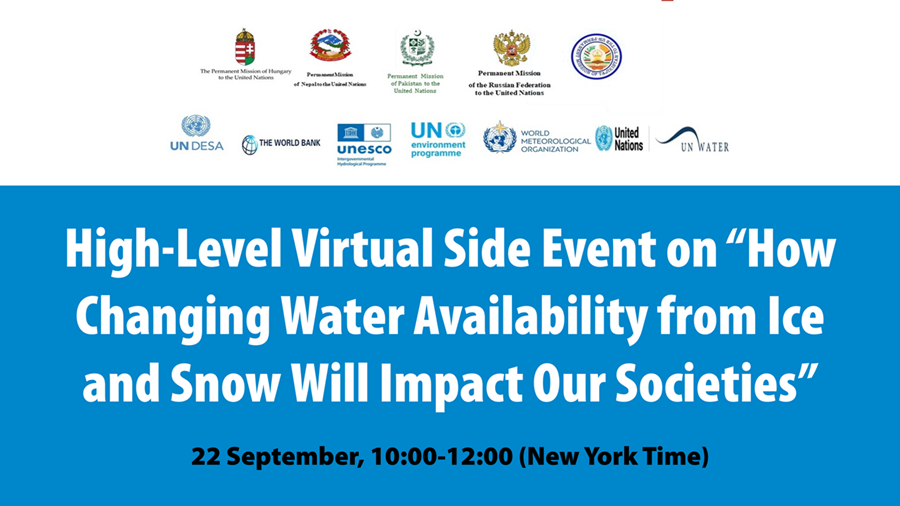High Level Side Event on How Changing Water Availability from Ice and Snow Will Impact Our Societies
« Back to list of video collections

This collection accommodates the video clips from the High Level Virtual Side Event on How Changing Water Availability from Ice and Snow Will Impact Our Societies, which was organized online on September 22, 2021.
Roberto Ranzi, Chair of IAHR's Technical Committee on Climate Change Adaptation, gave a talk at the event with the following summary of statements, which was also delivered at the 76th UNGA - HLSE on the Cryosphere:
The rapid retreat of glaciers and ice caps worldwide and evidences about a mean melt duration accelerating in Greenland points out how urgent are the reduction of GHG emissions and adaptation measures in the water sector
The use of fossil fuels for energy generation and especially of oil and coal, responsible of carbon particles emission and darkening of glaciers’ surface observed especially in the Arctic, needs to be reduced as much as possible. In the energy transition efforts the use of renewable energy as hydropower, and energy generation systems from sea waves, ocean currents, tides are appropriate mitigation measure in the water engineering sector also to preserve glaciers.
The adaptation to the observed and projected changes on the water cycle has to be based on a balanced combination of up-to-date traditional ‘grey’ engineering and ‘green’ Nature Based Solutions, in coastal defence, urban drainage and river training.
Water resources management of groundwater storages and reservoirs is another urgent adaptation measure to be implemented, thanks to the improved know-how developed in this field in the last decades
Below are some texts taken from the concept note of this event:
Glaciers, ice and snow hold 70% of the earth's freshwater resources. Climate change has accelerated the melting of the cryosphere worldwide and impacts the snow regime. Glaciers worldwide are on a retreat. This has lead to a change in the hydrological regime of rivers, characterized by the large amount of water flow, mudflows and floods in the spring months and lack of water and droughts in the summer months. Globally, 90% of disasters have been caused by mudflows, floods, storms, droughts, and other weather-related events, which continue to intensify with climate change. The recently released IPCC’s Sixth Assessment Report (August 2021) highlights that mountain and polar glaciers are melting for decades and permafrost thaw is irreversible at centennial timescale. The IPCC report also emphasizes that “climate change is intensifying the water cycle” which will bring more associated flooding and drought in many regions. 2.3 billion people live in water-stressed countries, of which 733 million live in high and critically water-stressed countries. In many places around the world, mudflows, floods and droughts will become more severe. In the mid to long term, available water from the cryosphere will become less and less and significantly impact our economies as well as the environment we live in.
UN World Water Development Report 2020 emphasizes that water is the “climate connector” that allows for greater collaboration and coordination across the majority of targets for climate change (Paris Agreement), sustainable development (2030 Agenda and its SDGs), and disaster risk reduction (Sendai Framework).Taking into account the close interlinkages between climate change and water issues and to catalyze a more integrated water and climate policy agenda, a High-level Advisory Panel entitled “Water and Climate Leaders” has been established by WMO and UN-Water, which will provide strategic guidance on integrating water and climate agendas at the highest level. At the inaugural meeting of the Water and Climate Leaders, Member of the Panel, President of the Republic of Tajikistan, H.E. Emomali Rahmon, proposed to declare 2025 as an International Year of Glaciers Preservation, which is expected to give impetus to a new global movement to take the necessary concerted action and to protect glaciers from intense melting and disappearance.
The side event will highlight the interlinkages between climate change, the cryosphere and our dependency on water to live as well as our vulnerability to water-related disasters and how water plays a pivotal role for adaptation to and mitigation of climate change impacts. It brings together high-level policymakers and stakeholders from the agricultural, energy and disaster risk reduction sectors.
Organizers: Hungary, Nepal, Pakistan, Russian Federation, Tajikistan, UNDESA, World Bank, UNESCO (IHP), UNEP, UN-Water and WMO.
-
Prof. Roberto Ranzi, Chair of IAHR's Technical Committee on Climate Change Adaptation
2021-10-13 -
Mr. Maarten Hoffman, Associate Programme Management Officer, UNEP
2021-10-13 -
Co-organizer, Deputy Permanent Representative of Russia
2021-10-13 -
Discussion and Closing of High-level virtual side event
2021-10-13